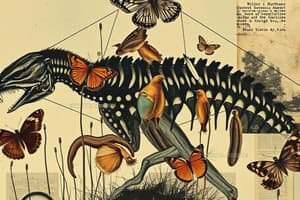Podcast
Questions and Answers
What is the 1st level of classification?
What is the 1st level of classification?
- Class
- Domain (correct)
- Phylum
- Kingdom
What is the 2nd level of classification?
What is the 2nd level of classification?
- Phylum
- Family
- Class
- Kingdom (correct)
What is the 3rd level of classification?
What is the 3rd level of classification?
- Order
- Family
- Genus
- Phylum (correct)
What is the 4th level of classification?
What is the 4th level of classification?
What is the 5th level of classification?
What is the 5th level of classification?
What is the 6th level of classification?
What is the 6th level of classification?
What is the 7th level of classification?
What is the 7th level of classification?
What is the last level of classification?
What is the last level of classification?
What is the classification of humans?
What is the classification of humans?
Domain _____
Domain _____
Kingdom ____
Kingdom ____
Phylum ________
Phylum ________
Class ______
Class ______
Order _________
Order _________
Family ________
Family ________
Genus _______
Genus _______
Species _________
Species _________
The two-part naming system is called the ______________
The two-part naming system is called the ______________
Genus is _________ Species is _______
Genus is _________ Species is _______
What is a biological species?
What is a biological species?
An organism resulting from the cross between species is called ________
An organism resulting from the cross between species is called ________
What are the 3 domains of life?
What are the 3 domains of life?
Characteristics of Domain Archae?
Characteristics of Domain Archae?
Characteristics of Domain Bacteria?
Characteristics of Domain Bacteria?
Characteristics of Domain Eukarya?
Characteristics of Domain Eukarya?
What is a vestigial structure?
What is a vestigial structure?
What are homologous structures?
What are homologous structures?
What are analogous structures?
What are analogous structures?
Difference between Eukarya and Prokarya?
Difference between Eukarya and Prokarya?
Fungi are _______
Fungi are _______
Chinook Salmon belong to what kingdom?
Chinook Salmon belong to what kingdom?
Coral belong to what kingdom?
Coral belong to what kingdom?
Amoeba belong to what kingdom?
Amoeba belong to what kingdom?
Mold belongs to what kingdom?
Mold belongs to what kingdom?
An example of a structure that's homologous with a human arm would be ________
An example of a structure that's homologous with a human arm would be ________
What is a cladogram?
What is a cladogram?
Flashcards are hidden until you start studying
Study Notes
Levels of Classification
- Domains serve as the highest rank in the biological classification system, including Eukarya, Bacteria, and Archae.
- Kingdoms categorize organisms under domains; for instance, Animalia is a kingdom under Eukarya.
- Phylum groups organisms based on major body plans, such as Chordata for animals with a backbone.
- Class further subdivides phylum; Mammalia includes all mammals.
- Orders cluster species based on similar characteristics; Primates include humans and monkeys.
- Families group closely related organisms, like Hominidae, which includes great apes and humans.
- Genus consists of closely related species; Homo is the genus for humans.
- Species is the most specific classification level, defining interbreeding populations; for humans, it is sapiens.
Human Classification
- Humans are classified within the following hierarchy:
- Domain: Eukarya
- Kingdom: Animalia
- Phylum: Chordata
- Class: Mammalia
- Order: Primates
- Family: Hominidae
- Genus: Homo
- Species: sapiens
Binomial Nomenclature
- A two-part naming system that provides a unique name to each species.
- The genus name is capitalized, while the species name is not.
Biological Species Definition
- A group of organisms capable of interbreeding and producing fertile offspring.
- Example: Horses and donkeys can mate to produce mules, which are sterile.
Hybrid Organism
- An organism resulting from crosses between species is termed a hybrid.
Domains of Life
- Three domains: Archae, Bacteria, and Eukarya.
Characteristics of Domain Archae
- Prokaryotic and the most ancient life form.
- Often found in extreme environments such as hot springs.
- Contains one kingdom: Kingdom Archae.
Characteristics of Domain Bacteria
- Prokaryotic and distinct from Archae based on habitat, cell wall structure, and RNA.
- Contains one kingdom: Kingdom Bacteria.
Characteristics of Domain Eukarya
- Eukaryotic and includes four kingdoms:
- Kingdom Protista
- Kingdom Plantae
- Kingdom Fungi
- Kingdom Animalia
Characteristics of Fungi
- Can be multicellular or unicellular.
- Heterotrophic, feeding on the growth of other organisms.
- Examples include mushrooms and molds.
Characteristics of Protista
- Comprises both multicellular and unicellular organisms.
- Can be heterotrophic or autotrophic, producing their own food.
- Examples include kelp and amoeba.
Characteristics of Plantae
- Exclusively multicellular and autotrophic.
- Organisms produce their own food via photosynthesis.
- Examples include trees and flowers.
Characteristics of Animalia
- Exclusively multicellular and heterotrophic.
- Organisms consume other organisms for energy.
- Examples include tigers and giraffes.
Vestigial Structures
- Evolutionary remnants that hint at an organism's ancestry.
- Examples include whale pelvic bones and the human appendix.
Homologous Structures
- Anatomically similar structures that may serve different functions.
- Example: Vertebrate forelimbs have similar bone structures.
Analogous Structures
- Structures that serve similar functions but do not share a common evolutionary origin.
- Examples include the wings of birds and insects.
Differences Between Eukarya and Prokarya
- Prokaryotes are single-celled organisms without a nucleus, whereas eukaryotes have a double-helix DNA structure and contain a nucleus.
Fungi Classification
- Fungi belong to the kingdom Fungi and are categorized as heterotrophic organisms.
Specific Organisms and Their Kingdoms
- Chinook Salmon: Animalia
- Coral: Animalia
- Amoeba: Protista
- Mold: Fungi
Homologous Example
- The bat wing is a homologous structure compared to the human arm.
Studying That Suits You
Use AI to generate personalized quizzes and flashcards to suit your learning preferences.




